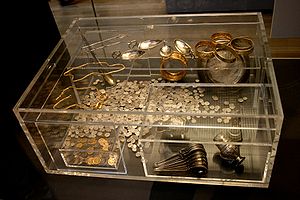The British Museum’s ‘Wikipedian-in-Residence’, Liam Wyatt, recently gave a talk to JISC on some of the work that the British Museum and Wikipedia were doing together.
In particular, Liam focussed on the Hoxne Challenge, a one-day event organised at the British Museum at the end of June 2010.

Rather than the usual model of building up an article slowly over time with geographically dispersed contribuitors, this event brought together numerous experts and enthusiasts to see if they could construct a high-quality in-depth article on a particular topic.
The topic was the Hoxne Hoard, a discovery of late Roman gold and silver coins, and other previous items in 1992,
The team included various experts from the British Museum plus interested Wikipedia enthusiasts, some of whom attended the event, some of whom were online.
The result, after six hours of editing, was an incredibly detailed article on the Hoxne Hoard, fully referenced with 112 footnotes.
Such a process suggests a different way of approaching crowdsourcing – rather than indiviudals donating indiviudal pieces of digitised material or related metadata, the individuals worked as a team, structuring up their knowledge and expertise according to the basic rules relating to the creation of a Wikipedia article.
While the process could not be used for every single culutral item, in certain contexts it could be incredibly powerful of building up knowledge.
For much detail on the success of the event, have a read of Liam Wyatt’s blog post
